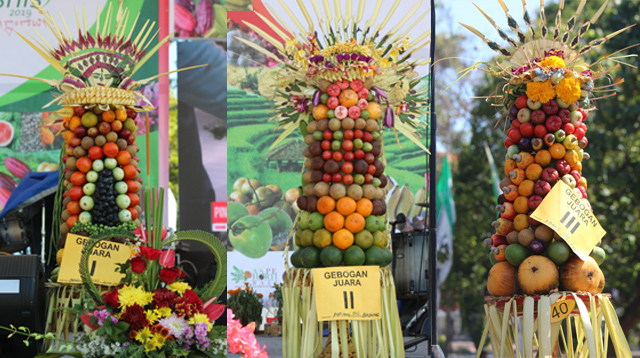- Gebogan is an arrangement of fruits and cakes as an expression of gratitude to God
- There are large numbers of gebogan offered at piodalan or temple festivals
If you have ever witnessed the opening of a cultural parade or piodalan (temple festival) at a Hindu temple in Bali, you will see that there are many kinds of fruit and cakes that women hold on their head. Well, that’s called gebogan or pajegan.
What is gebogan?
Basically, this gebogan is made as a food offering in a yadnya or sincere sacrifice to express gratitude. Besides, people ask for grace by such a means and after that the grace will be enjoyed again.
Philosophically, gebogan as expression of gratitude which is shaped like a towering mountain equipped with canang and sampiyan means offering of the Hindus to God as the Creator of the universe.
Materials and how to make gebogan
In essence, the kinds of fruits used to compose the gebogan or fruit and cake arrangement is called Panca Rengga. They are classified in terms of its producing process
- Fruits that come from their roots: yam and cassava
- Fruit scales: snakefruit, pineapple and dragon fruit
- Fruit that bears fruit only once and after which the tree immediately dies, like bananas
- Fruits born from flowers such as mangoes, oranges and guavas
- Fruits that are born directly from the tree such as lychee, durian and jackfruit
Various kinds of fruit and snacks are neatly arranged on a wooden tray. Then, a small banana stem is pierced with a small iron rod snugly in the middle of the bottom of the tray. Well, the fruits are pierced by a stick or a skewer and then plugged into this banana stem. The creations may vary depending on each individual’s artistic sense.
Then, at its peak is placed a canang sari which represents the offering itself. The form of offerings arranged in such a way gives a sense of beauty. Meanwhile, the size is not important because the most important thing here is the ability and sincerity of the people who offer.
The provincial government of Bali once recommended using local fruits to make the gebogan. Religiously, all these fruits are celebrated on the tree once every 210 days. Hindus celebrate the Tumpek Wariga ceremony which is especially dedicated to plants, including fruit plants. Then economically, the use of local fruits will help empower local fruit farmers.
Gebogan as a form of offering is usually made by each family. Well, you can imagine if one customary village consists of 500 families. They will amount to 500 pieces of gebogan.










